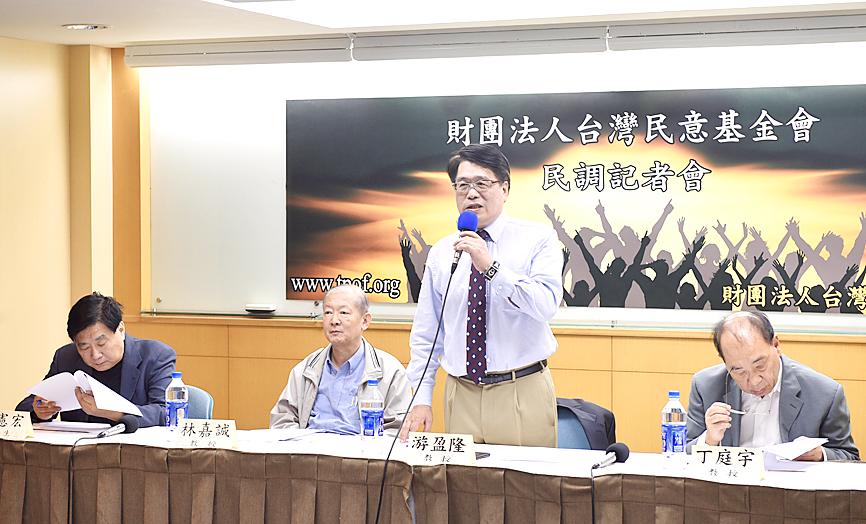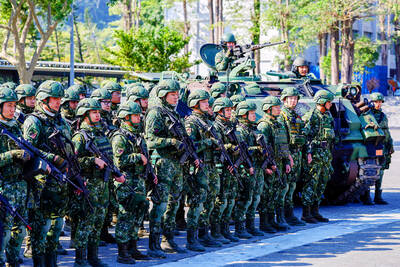Nearly 60 percent of Taiwanese disagreed with a statement by former president Ma Ying-jeou (馬英九) that if Beijing were to wage war against Taiwan, “the first battle will be the last,” a survey released yesterday by the Taiwanese Public Opinion Foundation showed.
The poll showed that 33.9 percent of respondents agreed with the statement, 58.3 percent disagreed and 3.7 percent had no opinion.
Ma on Aug. 10 said that if there were to be a war, the Chinese Communist Party (CCP) would make it quick, so that its invasion on Taiwan would be over by the time the US military comes to Taiwan’s aide.

Photo: Peter Lo, Taipei Times
“Not to mention that under the current circumstances, it would be impossible for the US military to come at all,” he added.
Defending his statement, Ma on Saturday said that he based his remarks on the Annual Assessment of the People’s Republic of China’s Political and Military Developments 2018 report by the Institute of National Defense and Security Research.
Not accepting the so-called “1992 consensus” is bad policy, as it would recklessly push the nation toward war, he said, adding that President Tsai Ing-wen (蔡英文), as the national leader, must strive to avoid war.
The “1992 consensus” — a term that former Mainland Affairs Council chairman Su Chi (蘇起) in 2006 admitted making up in 2000 — refers to a tacit understanding between the Chinese Nationalist Party (KMT) and the CCP that both sides of the Taiwan Strait acknowledge that there is “one China,” with each side having its own interpretation of what “China” means.
Foundation chairman Michael You (游盈隆) said the poll has validated Tsai’s criticism of Ma — that he is “standing on the opposite side of mainstream public opinion.”
The poll also asked respondents whether the Chinese People’s Liberation Army’s Eastern Theater Command’s statement on Aug. 13 that it had conducted military exercises in the Taiwan Strait had worried them, with 40.8 percent saying that it did, and 57.8 percent saying otherwise.
The poll, which was conducted by Focus Survey Research, collected 1,090 valid responses on Monday and Tuesday last week, and had a margin of error of 2.97 percentage points.
In related news, former minister of national defense Michael Tsai (蔡明憲) accused Ma of publicly belittling the Taiwanese military and trying to force Taiwanese to accept Beijing’s “one country, two systems” formula.
Ma’s remarks bostering China’s image verges on “treason,” said Michael Tsai, now president of the Taiwan United Nations Alliance.
With the US government approving the sale of military weapons to Taiwan, the nation’s defensive weapons have become increasingly sophisticated, he said.
Tsai Ing-wen’s dedication to building indigenous submarines and warplanes also deserve recognition, he added.
By contrast, during Ma’s administration, the government lacked a proper awareness of the CCP threat, making his eight-year presidential tenure a time when CCP infiltration into Taiwan was in full swing, he said.
Ma’s pro-China policy also led the US Department of Defense to cast doubt on the loyalty of the Taiwanese military at the time, he said.
The all-volunteer military system promoted by Ma during his presidential term has resulted in a lack of base-level soldiers, Michael Tsai said, urging Tsai Ing-wen to consider whether Taiwan should strike a balance between an all-volunteer and a conscription military system in the face of Chinese military intimidation.
The government should raise the national defense budget from 2 percent of GDP to 3 percent, he said, adding that China’s defense budget has been growing by an average of 8.5 percent each year, he said.
The president should act more proactively to establish mechanisms and platforms in which Taiwan, the US and Japan can collaborate on safeguarding regional peace and stability in the Taiwan Strait, the South China Sea and the East China Sea, he said.
Additional reporting by Chung Li-hua

UNILATERAL MOVES: Officials have raised concerns that Beijing could try to exert economic control over Kinmen in a key development plan next year The Civil Aviation Administration (CAA) yesterday said that China has so far failed to provide any information about a new airport expected to open next year that is less than 10km from a Taiwanese airport, raising flight safety concerns. Xiamen Xiangan International Airport is only about 3km at its closest point from the islands in Kinmen County — the scene of on-off fighting during the Cold War — and construction work can be seen and heard clearly from the Taiwan side. In a written statement sent to Reuters, the CAA said that airports close to each other need detailed advanced

Tropical Storm Fung-Wong would likely strengthen into a typhoon later today as it continues moving westward across the Pacific before heading in Taiwan’s direction next week, the Central Weather Administration (CWA) said. As of 8am, Fung-Wong was about 2,190km east-southeast of Cape Oluanpi (鵝鑾鼻), Taiwan’s southernmost point, moving westward at 25kph and possibly accelerating to 31kph, CWA data showed. The tropical storm is currently over waters east of the Philippines and still far from Taiwan, CWA forecaster Tseng Chao-cheng (曾昭誠) said, adding that it could likely strengthen into a typhoon later in the day. It is forecast to reach the South China Sea

Almost a quarter of volunteer soldiers who signed up from 2021 to last year have sought early discharge, the Legislative Yuan’s Budget Center said in a report. The report said that 12,884 of 52,674 people who volunteered in the period had sought an early exit from the military, returning NT$895.96 million (US$28.86 million) to the government. In 2021, there was a 105.34 percent rise in the volunteer recruitment rate, but the number has steadily declined since then, missing recruitment targets, the Chinese-language United Daily News said, citing the report. In 2021, only 521 volunteers dropped out of the military, the report said, citing

WEATHER Typhoon forming: CWA A tropical depression is expected to form into a typhoon as early as today, the Central Weather Administration (CWA) said yesterday, adding that the storm’s path remains uncertain. Before the weekend, it would move toward the Philippines, the agency said. Some time around Monday next week, it might reach a turning point, either veering north toward waters east of Taiwan or continuing westward across the Philippines, the CWA said. Meanwhile, the eye of Typhoon Kalmaegi was 1,310km south-southeast of Oluanpi (鵝鑾鼻), Taiwan’s southernmost point, as of 2am yesterday, it said. The storm is forecast to move through central